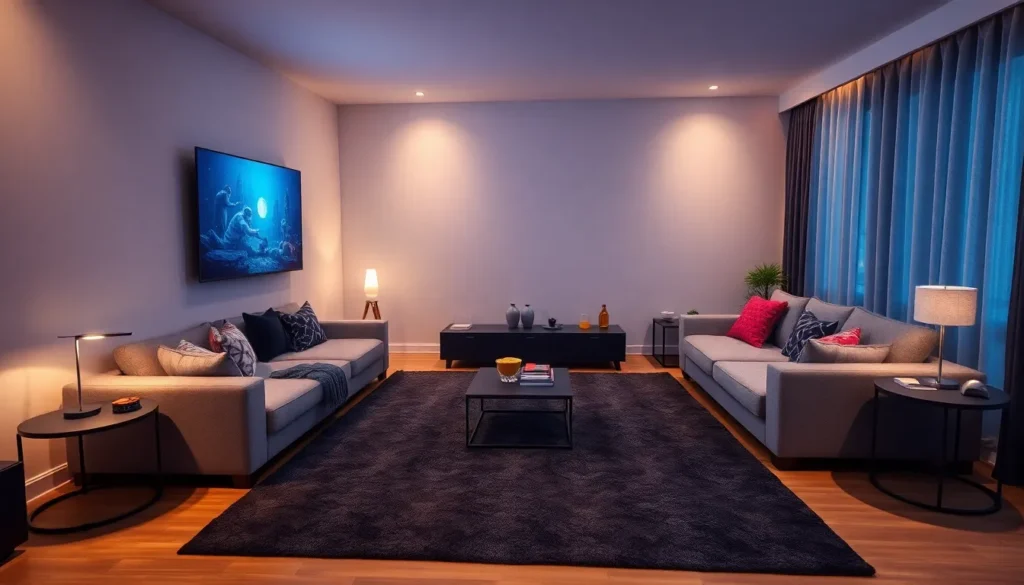We’ve all dreamed of transforming our living rooms into the ultimate entertainment destination where movie nights feel like true cinematic experiences. The good news? You don’t need a dedicated theater room or massive budget to create an impressive home theater setup that’ll make your friends envious and your family grateful.
Whether you’re working with a cozy apartment living room or a spacious family area we’ll show you how to maximize your space for optimal viewing pleasure. From strategic seating arrangements and lighting answers to sound system setups that won’t expensive these practical ideas will elevate your entertainment game significantly.
Ready to turn your ordinary living room into an extraordinary home theater? We’re about to share game-changing tips that’ll help you create the perfect balance between daily functionality and cinematic magic right in your own home.
Create a Dedicated Viewing Zone
Establishing a distinct viewing area within your living room transforms the space into a functional home theater without permanent structural changes. We’ll show you how to use furniture placement and visual boundaries to create that perfect entertainment zone.
Define Your Theater Space with Strategic Furniture Placement
Position your seating in a U-shape or L-configuration to create natural boundaries around your viewing area. This arrangement makes everyone feel included while establishing clear sight lines to your screen. Angle your sofa and chairs at 15 to 30 degrees toward the television for optimal viewing comfort.
Place your main seating 8 to 12 feet away from your screen depending on your TV size and room dimensions. This distance reduces eye strain and provides the ideal viewing experience. Move side tables and accent chairs to frame the perimeter of your theater zone.
Create a floating furniture arrangement by pulling your sofa away from the wall by 12 to 18 inches. This technique defines the viewing space while allowing foot traffic to flow behind the seating area. Add a console table or bookshelf behind the sofa to further separate your theater zone from the rest of the room.
Use your largest piece of furniture as an anchor to establish the primary viewing position. Orient everything else around this central piece to create a cohesive entertainment area. Consider adding a sectional sofa that naturally wraps around your viewing space.
Use Area Rugs to Separate the Entertainment Area
Select a large area rug that extends at least 18 inches beyond your seating arrangement on all sides. This creates a visual foundation for your home theater zone while defining the space without walls. Choose rugs measuring 9×12 feet or larger for most living room theater setups.
Layer multiple rugs to create depth and interest in your entertainment area. Place a smaller accent rug under your coffee table while using a larger base rug to anchor the entire seating arrangement. This technique adds visual weight to your theater zone.
Choose darker colored rugs to minimize light reflection and create that authentic cinema atmosphere. Deep blues, charcoal grays, or rich burgundies work exceptionally well for home theater spaces. These colors also hide stains better than lighter alternatives.
Position your rug so the front legs of your seating rest on the edge while the back legs remain on your floor. This placement technique grounds your furniture while creating clear boundaries between your theater zone and adjacent living spaces.
Choose the Perfect Display Technology
We’ve established our viewing zone, and now it’s time to select the centerpiece that’ll bring our home theater vision to life. The display technology we choose determines the overall impact and viewing experience of our living room cinema.
Consider Large Screen TVs for Maximum Impact
Large screen TVs offer the most straightforward path to creating an impressive home theater setup. Modern TVs deliver exceptional picture quality with minimal installation requirements compared to other display options. We can mount them directly on the wall or place them on a media console without complex wiring or calibration.
Benefits of choosing large screen TVs include reliable performance in various lighting conditions. Unlike projectors, TVs maintain their brightness and color accuracy even when ambient light enters our living room during daytime viewing. This flexibility makes them ideal for spaces that serve multiple purposes throughout the day.
Size options for large screen TVs range from 65 inches to 85 inches or larger. These dimensions provide substantial visual impact while fitting comfortably in most living room layouts. We’ll find that larger screens create more immersive experiences without requiring complete room darkness.
Explore Projector Options for Cinema-Style Experience
Projectors deliver the most authentic cinema experience possible in our living room setup. They can display images ranging from 100 to 300 inches diagonal, creating a truly theatrical atmosphere that large TVs simply can’t match. This technology transforms any wall or dedicated screen into our personal movie theater.
Cinema-style projectors work best in rooms where we can control ambient lighting. We’ll need to consider blackout curtains or shades to achieve optimal picture quality during daytime viewing. The ability to dim or eliminate room lighting significantly enhances the projector’s performance and creates that authentic theater ambiance.
Screen pairing with projectors requires additional planning and investment. We can choose between fixed screens that mount permanently on the wall or retractable options that disappear when not in use. This flexibility allows our living room to maintain its everyday functionality while providing exceptional movie experiences.
Evaluate Screen Size Based on Room Dimensions
Room dimensions directly influence the optimal screen size for comfortable viewing. Screens that are too large for the space can require viewers to move their heads excessively to see the entire picture, creating fatigue during longer viewing sessions. We need to balance impact with comfort to create an enjoyable experience.
Distance calculations help determine the perfect screen size for our space. The ideal viewing distance typically ranges from 1.5 to 2.5 times the screen’s diagonal measurement. For example, a 75-inch screen works best when our main seating is positioned 9 to 15 feet away from the display.
Viewing angles also factor into our screen size decision. We should ensure that all seating positions in our theater zone can see the entire screen without strain or distortion. Corner seats and secondary viewing positions need clear sight lines to the display for an inclusive viewing experience.
Design Optimal Seating Arrangements
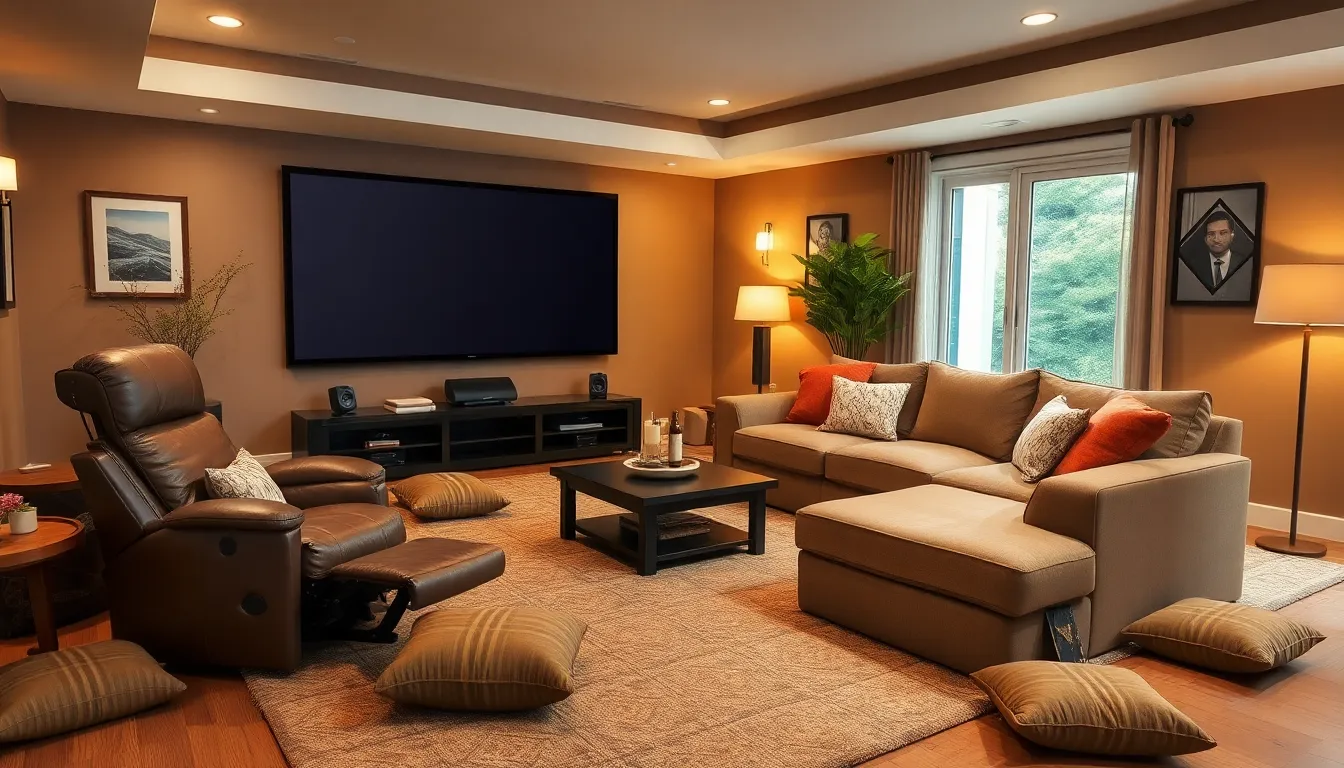
We need to choose seating that balances comfort with functionality to create the perfect home theater experience. Strategic furniture selection transforms your living room into a cozy entertainment hub where everyone can enjoy movie nights together.
Select Comfortable Sectional Sofas for Family Viewing
Sectional sofas provide the ideal foundation for family movie nights by offering ample space for multiple people to sit comfortably during extended viewing sessions. We recommend positioning these versatile pieces to create natural conversation areas while maintaining clear sight lines to your display. Large sectionals work particularly well in spacious living rooms where you can arrange seating 8 to 12 feet from the screen for optimal viewing comfort.
Consider L-shaped or U-shaped sectionals that naturally guide everyone’s attention toward the entertainment center. These configurations allow family members to stretch out while staying connected to the group viewing experience. Memory foam cushions and deep seats enhance comfort during lengthy movie marathons, making sectionals a smart investment for frequent entertainment.
Add Recliners for Premium Comfort
Recliners offer an enhanced viewing experience with adjustable positions that let you customize comfort levels throughout any movie or show. We suggest incorporating these premium seating options as accent pieces that complement your main sectional arrangement. Individual recliners work exceptionally well for dedicated movie enthusiasts who want theater-quality comfort in their living room setup.
Power recliners with built-in USB charging ports and cup holders elevate the home theater experience to match commercial cinema standards. Position recliners at slight angles to the screen to prevent neck strain during extended viewing sessions. Leather or high-quality fabric recliners also add visual appeal while providing the ultimate relaxation experience for your home entertainment space.
Incorporate Floor Cushions for Flexible Seating
Floor cushions provide flexible seating options that allow for different configurations based on the number of viewers and entertainment needs. We find these portable seating answers particularly valuable for accommodating unexpected guests or creating intimate viewing arrangements for smaller groups. Large, plush floor pillows can transform any open floor space into comfortable theater seating within minutes.
Storage ottomans that double as floor seating offer practical answers for keeping blankets, remotes, and movie snacks organized while providing extra seating capacity. Consider washable covers for easy maintenance after snack-filled movie nights. Arrange floor cushions in front of your main seating to create stadium-style viewing levels that ensure everyone has an unobstructed view of the screen.
Install Professional Sound Systems
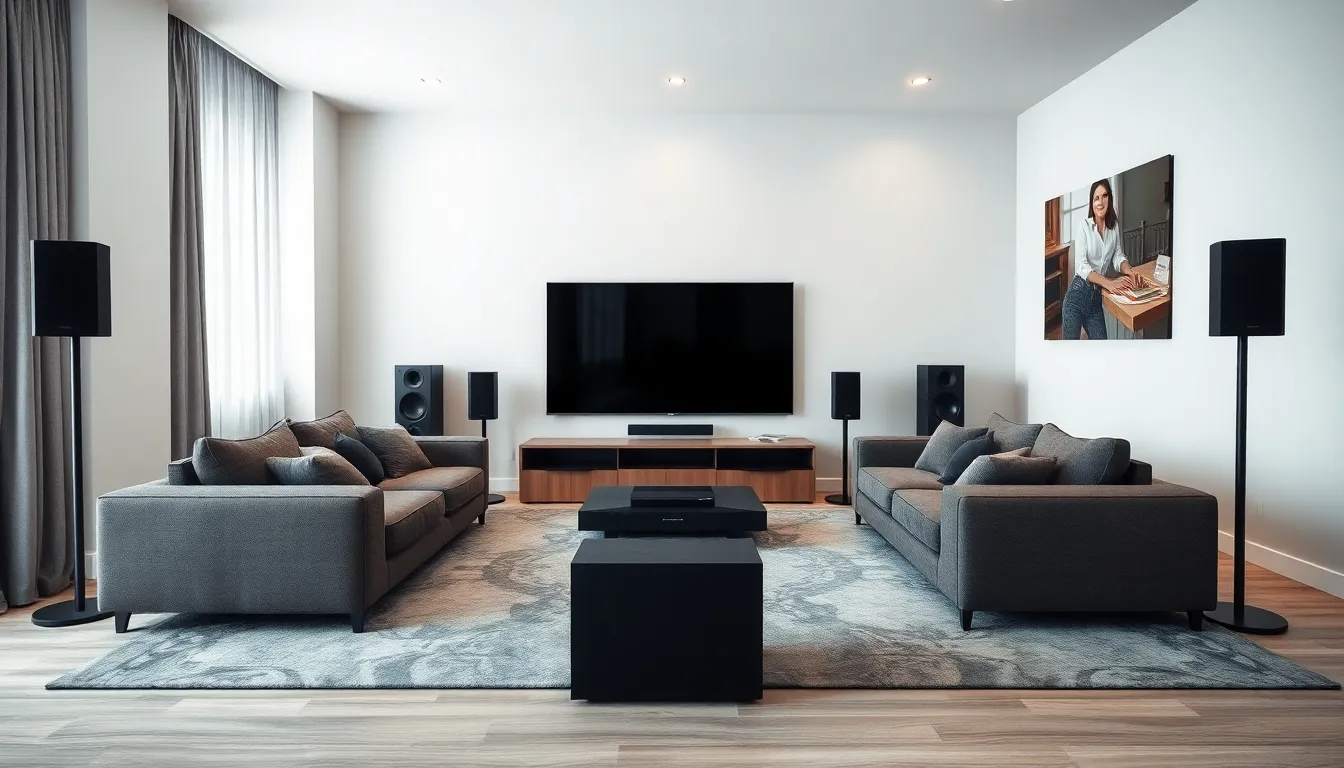
Audio quality transforms your living room home theater experience from ordinary to extraordinary. Professional sound systems create the immersive environment that truly brings movies and shows to life.
Set Up Surround Sound Speakers
Position surround sound speakers 1 to 2 feet above ear height to achieve optimal audio distribution throughout your space. Angling speakers toward the primary viewing area ensures every listener receives clear, balanced sound regardless of their seating position.
Tower speakers and bookshelf speakers work together to create a comprehensive audio foundation for your home theater setup. Center speakers handle dialogue and vocal clarity, while freestanding speakers with up-firing modules add impressive height channels that enhance the three-dimensional sound experience.
Ceiling speakers provide the ultimate immersive experience by delivering overhead audio effects that traditional floor-mounted systems can’t match. We recommend installing these during renovation projects when wall access is readily available.
AV receivers serve as the command center for your entire audio system, supporting multiple HDMI inputs and outputs to manage all your connected devices efficiently. Choose receivers with enough channels to support your desired speaker configuration and future expansion plans.
Consider Soundbars for Space-Saving Answers
Soundbars offer an ideal solution for smaller living rooms where traditional speaker systems might overwhelm the available space. These compact devices deliver impressive audio quality without requiring multiple speakers positioned around the room.
Wireless subwoofers often accompany modern soundbars to provide enhanced low-frequency response without additional cable management. This combination maintains the clean, minimalist aesthetic that many homeowners prefer while still delivering rich, full-range audio.
Installation simplicity makes soundbars attractive for homeowners who want professional sound quality without complex setup procedures. Most models connect directly to your TV with a single cable and sync wirelessly with their accompanying subwoofers.
Add Subwoofers for Enhanced Bass Experience
Subwoofers enhance low-frequency sounds that standard speakers and soundbars can’t reproduce effectively, creating the rumbling effects that make action sequences truly thrilling. We’ve found that movies with extensive sound design benefit dramatically from dedicated bass management.
Corner placement maximizes bass resonance by utilizing room boundaries to amplify low-frequency output naturally. Positioning your subwoofer against a wall also increases bass response while helping to integrate the sound more seamlessly with your main speakers.
High-speed HDMI cables and properly routed speaker wires minimize setup clutter and ensure optimal signal transmission throughout your system. Consider pre-wiring sound systems into walls during construction or renovation for the sleekest possible installation.
Master Lighting Control for Ambiance

Perfect lighting transforms our living room theater from ordinary to extraordinary. Creating the right atmosphere requires strategic control over various light sources to enhance our viewing experience.
Install Dimmer Switches for Adjustable Mood Lighting
Installing dimmer switches gives us complete control over traditional lighting fixtures throughout our home theater space. We can adjust brightness levels from full illumination for cleaning and setup to minimal ambient lighting during movie watching. Smart dimmer switches integrate seamlessly with home automation systems, allowing us to preset lighting scenes for different activities like gaming, movie nights, or casual TV viewing.
Standard wall switches limit us to simple on and off functions, while dimmers provide graduated control that matches our exact needs. We’ll want to install dimmers on overhead lights, table lamps, and wall sconces to create layered lighting options. Motion sensor dimmers add convenience by automatically adjusting light levels when we enter or leave the room.
Add LED Strip Lights Behind TV for Bias Lighting
Adding LED strip lights behind our TV creates bias lighting that reduces eye strain and enhances picture quality. This lighting technique illuminates the wall behind our display, providing gentle background light that helps our eyes adjust between bright screen content and dark room conditions. We can choose from color changing LED strips that sync with our content or neutral white strips for consistent ambient lighting.
Proper bias lighting should be approximately 10% of our screen’s peak brightness to achieve optimal viewing comfort. USB powered LED strips connect directly to our TV, turning on and off automatically with our display. We should position the strips around the entire perimeter of our TV back panel, ensuring even light distribution across the wall.
Use Blackout Curtains to Control Natural Light
Using blackout curtains eliminates unwanted natural light that can wash out our screen and create glare during daytime viewing. These specialized window treatments block up to 99% of outside light, giving us complete control over our room’s lighting conditions. We can choose from various styles including thermal blackout panels that also provide energy efficiency benefits.
Motorized blackout curtains integrate with our smart home systems, allowing us to adjust natural light levels with voice commands or smartphone apps. Room darkening shades offer an alternative solution for windows where complete blackout isn’t necessary. We should measure our windows carefully and select curtains that extend beyond the window frame to prevent light leakage around the edges.
Optimize Room Acoustics and Layout

Sound quality makes or breaks your home theater experience, and proper room acoustics can transform ordinary audio into cinema-grade immersion.
Position Furniture to Minimize Sound Reflection
Arranging seating and speakers forms the foundation of excellent home theater acoustics. We recommend positioning your main seating 7 feet from the screen to create an optimal viewing and listening distance for standard rooms. Place front speakers at the ends of your console or entertainment unit, forming an equilateral triangle between the left speaker, right speaker, and your primary listening position for proper stereo imaging.
Avoid parallel surfaces when arranging furniture since sound waves reflect directly off parallel walls and create echo or muddy audio. Center your main seating relative to both the TV and speakers to maximize sound distribution and ensure perfect visual alignment. Even smaller or non-dedicated rooms benefit significantly from strategic component arrangement that prioritizes clarity and minimizes unwanted sound reflections.
Add Soft Furnishings to Reduce Echo
Soft materials absorb sound reflections and dramatically improve your home theater’s audio clarity. Place area rugs on hard floors to capture sound waves before they bounce back and create unwanted echoes. Thick curtains on windows provide dual benefits by blocking outside light and absorbing sound that would otherwise reflect off glass surfaces.
Upholstered furniture serves as natural acoustic treatment in your living room theater setup. Sofas and chairs with fabric covers absorb sound much better than leather or hard surfaces. Add throw pillows and blankets to further reduce echo while creating a cozy atmosphere that enhances your movie-watching experience.
Consider Acoustic Panels for Professional Results
Mounting acoustic panels on walls and ceilings delivers professional-grade sound improvement by absorbing mid and high-frequency reflections. These panels reduce echo significantly and sharpen dialogue clarity, making conversations in movies easier to follow without cranking up the volume.
Choose panels that blend seamlessly with your existing decor or select decorative options that enhance your room’s aesthetic appeal. Discreet placement ensures your living room maintains its everyday functionality while providing superior acoustic performance during movie nights. Strategic panel positioning targets problem areas where sound reflections typically occur, transforming your space into a true home theater environment.
Integrate Smart Home Technology
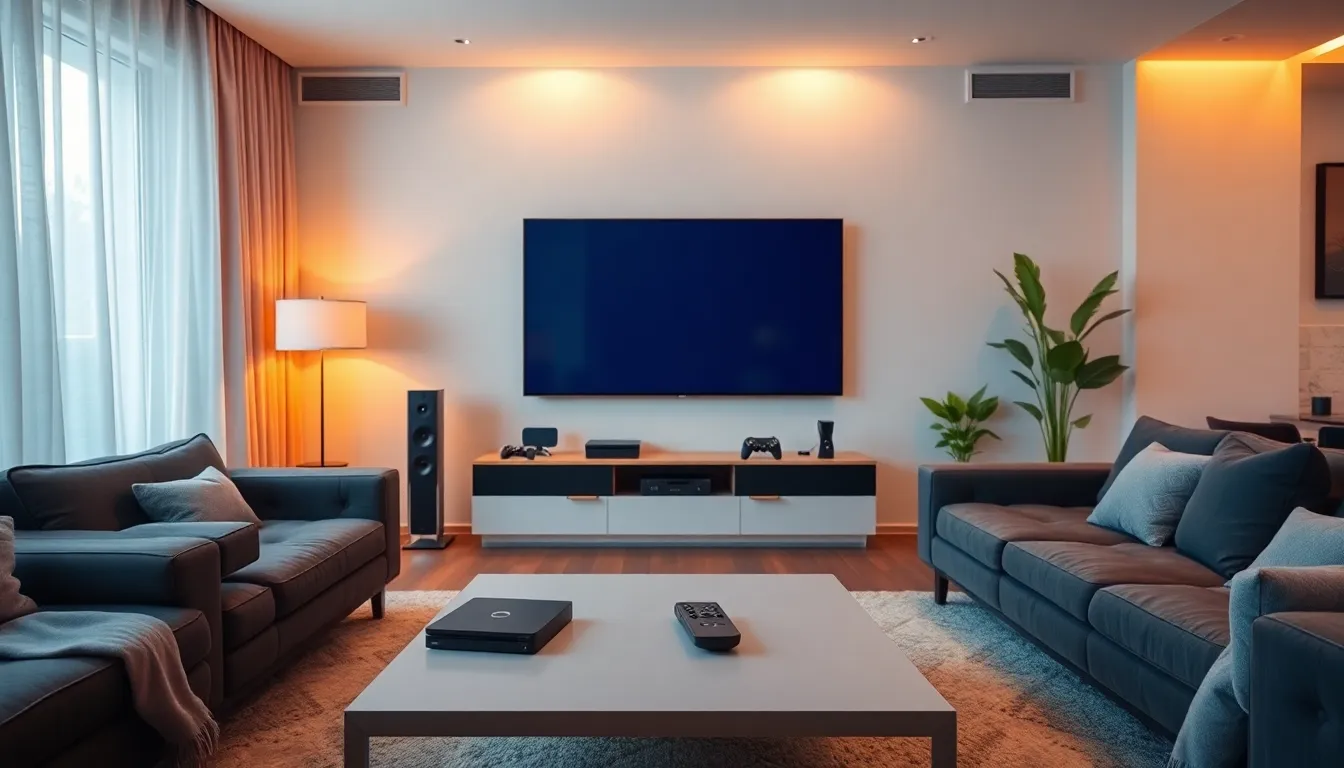
Smart home integration transforms your living room theater into an automated entertainment hub that responds to your preferences and creates the perfect viewing environment with minimal effort.
Connect Streaming Devices and Gaming Consoles
Seamless connectivity between your streaming devices and gaming consoles creates a harmonious viewing experience that eliminates technical frustrations. We recommend connecting popular streaming devices like Roku and Apple TV alongside gaming consoles such as PlayStation and Xbox to ensure comprehensive entertainment options.
Synchronized experiences optimize both picture and audio quality simultaneously when all devices work together effectively. We’ve found that proper device integration eliminates compatibility issues and ensures smooth transitions between different entertainment sources.
Network optimization becomes crucial when multiple devices share your home’s bandwidth during peak usage times. We suggest using wired ethernet connections for gaming consoles and 4K streaming devices to maintain consistent performance levels.
Use Universal Remote Controls for Simplified Operation
Simplified operation reduces clutter and complexity by consolidating multiple device controls into a single remote solution. We recommend investing in programmable universal remotes that can manage your TV, sound system, streaming devices, and lighting simultaneously.
Easy access to all entertainment options eliminates the frustration of switching between multiple remotes throughout your viewing sessions. We’ve discovered that modern universal remotes can store custom macros that automatically adjust multiple settings with one button press.
Smart remote apps on your smartphone or tablet provide additional control flexibility while maintaining the convenience of centralized device management. We find these apps particularly useful for fine-tuning audio levels and accessing advanced settings without interrupting the viewing experience.
Install Smart Lighting Systems
Automated lighting adjusts brightness and color temperature based on the content you’re watching for a truly immersive entertainment experience. We recommend installing smart LED bulbs that can automatically dim during movie playback and brighten during intermissions.
Personalized ambiance creates distinct lighting scenes for different entertainment activities such as movie nights, sports events, or gaming sessions. We’ve found that warm amber tones work best for dramatic films while cooler blue tones enhance action sequences and gaming experiences.
Voice control integration allows you to adjust lighting without searching for remotes or smartphone apps during critical viewing moments. We suggest connecting your smart lighting system to voice assistants like Alexa or Google Assistant for hands-free operation that won’t disturb other viewers.
Enhance Comfort with Accessories
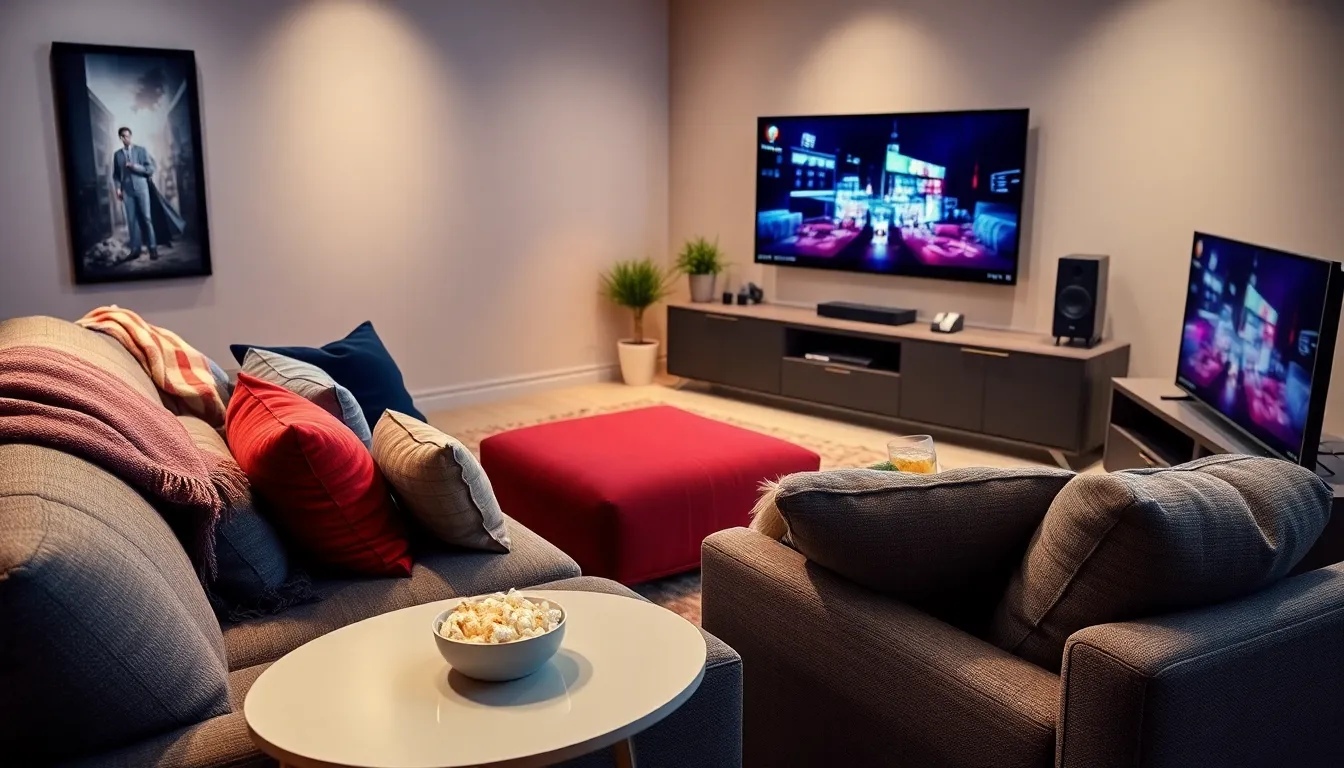
Creating the perfect home theater experience involves more than just audio and visual elements. We’ll transform your living room into a comfortable entertainment hub with carefully selected accessories that enhance both functionality and relaxation.
Add Side Tables for Snacks and Beverages
Strategically placing side tables near each seating area ensures you’ll never miss a moment of your favorite movie while reaching for refreshments. We recommend positioning C-shaped side tables that slide under sofas and chairs, allowing easy access to snacks and drinks without taking up floor space. Glass-top or wood-finish tables complement most living room decors while providing stable surfaces for beverages, popcorn bowls, and remote controls.
Small accent tables with built-in cup holders offer additional convenience during extended viewing sessions. We suggest choosing tables with lower shelves or drawers to store extra napkins, coasters, and frequently used items within arm’s reach.
Include Storage Answers for Media Equipment
Organizing media equipment creates a cleaner aesthetic while protecting your valuable electronics from dust and damage. We recommend investing in wide TV consoles or entertainment centers that accommodate gaming consoles, streaming devices, cable boxes, and sound system components behind closed doors.
Floating media cabinets maximize floor space while providing ample storage for DVDs, games, and accessories. These wall-mounted answers work particularly well in smaller living rooms where floor space is at a premium.
Wire management systems help eliminate cable clutter that can detract from your home theater’s appearance. We suggest using cord organizers and cable trays to route power and HDMI cables neatly behind your entertainment center, creating a professional, organized look.
Provide Blankets and Pillows for Cozy Viewing
Soft textiles transform any seating arrangement into a comfortable retreat for movie marathons and binge-watching sessions. We recommend keeping a collection of throw blankets in a decorative basket near your main seating area, ensuring everyone can stay warm during longer films.
Memory foam and down-filled throw pillows provide additional lumbar support and comfort during extended viewing periods. Choose pillows in colors that complement your existing decor while adding texture and visual interest to your seating arrangement.
Heated throw blankets offer luxury comfort during winter months, creating a spa-like experience in your home theater. We suggest selecting blankets with multiple heat settings and automatic shut-off features for safety and energy efficiency.
Manage Cables and Equipment
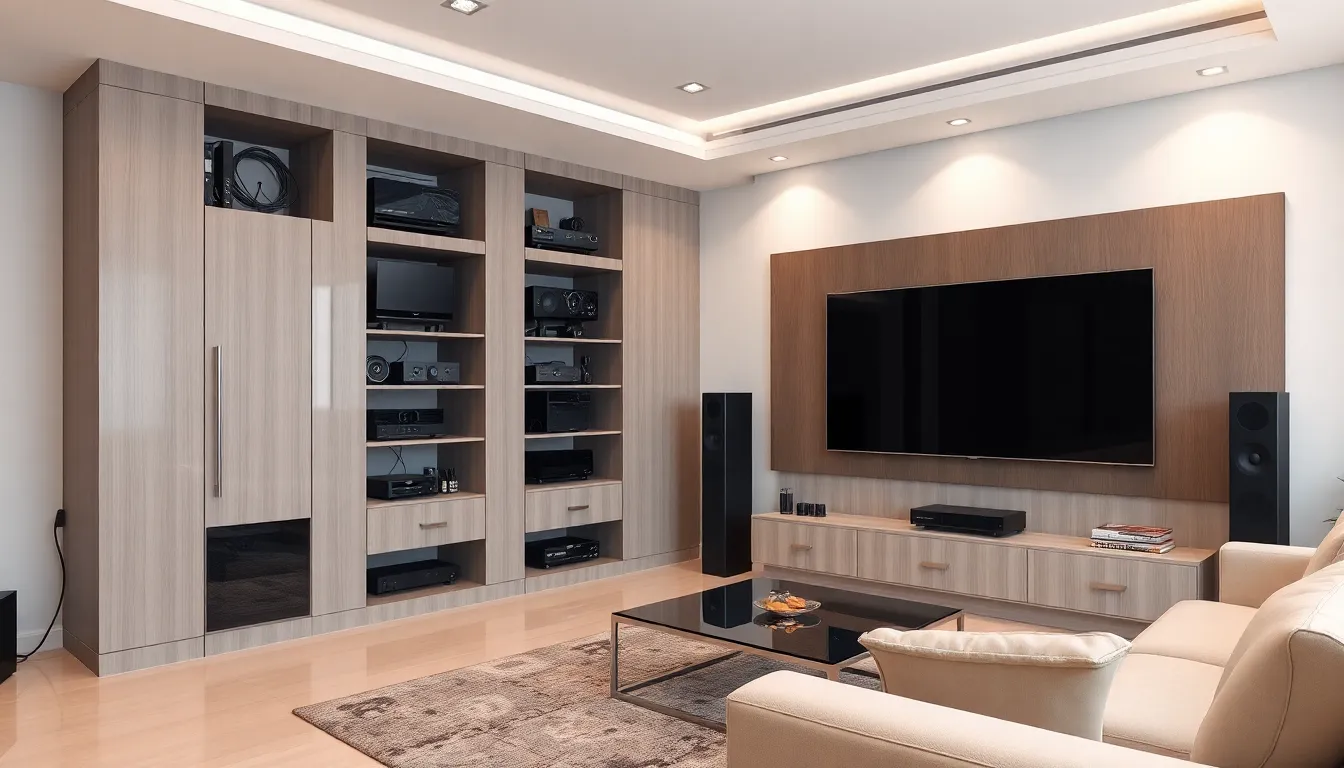
Managing cables and equipment properly transforms a cluttered living room into a polished home theater setup. We’ll show you how to keep everything organized while maintaining easy access to your devices.
Hide Wiring with Cable Management Systems
Cable organizers and raceways keep your living room tidy by eliminating visual clutter that can distract from your viewing experience. These systems prevent tripping hazards while maintaining a clean aesthetic throughout your home theater space.
Behind wall cable concealment systems offer the most professional appearance by completely hiding wires from view. We recommend routing cables through wall cavities whenever possible to enhance your overall viewing experience.
Channel cable management systems attach directly to walls or baseboards for a streamlined look. These answers work perfectly when in wall routing isn’t feasible but you still want to minimize visible wiring.
Use Entertainment Centers for Organized Storage
Wide TV consoles with storage cubbies provide the perfect solution for housing media players and gaming consoles in one centralized location. This approach keeps your room organized while ensuring all equipment remains easily accessible.
Entertainment centers eliminate clutter by providing dedicated spaces for each device. We suggest choosing units with adjustable shelving to accommodate equipment of various sizes and ensure proper ventilation.
Built in storage answers create seamless integration with your existing decor while maximizing functionality. These custom options often include wire management features that further enhance your home theater’s professional appearance.
Plan Power Outlet Placement Strategically
Position outlets near your entertainment center to ensure easy access to power for all devices without relying on extension cords. This strategic placement helps maintain a clean setup while providing adequate power distribution.
Multiple outlet configurations work best when planned during room design or renovation phases. We recommend installing at least six outlets behind your entertainment center to accommodate future equipment additions.
Surge protection should be integrated into your power planning to protect valuable equipment from electrical damage. Quality surge protectors with multiple outlets provide both safety and convenience for your home theater setup.
Conclusion
Transforming your living room into a home theater doesn’t require a massive renovation or expensive equipment. By focusing on strategic furniture placement quality audio systems and proper lighting control you can create an impressive entertainment space that serves double duty.
The key lies in balancing comfort with functionality while maintaining your room’s everyday usability. From selecting the right display technology to optimizing acoustics every element works together to deliver that authentic cinema experience.
With smart home integration cable management and thoughtful comfort accessories your living room theater will become the favorite gathering spot for family and friends. Start with one or two improvements and gradually build your perfect setup over time.
Frequently Asked Questions
What is the ideal distance to place seating from the TV screen?
The optimal distance is 8 to 12 feet from the screen for comfortable viewing. This distance ensures you can enjoy the full picture without eye strain while maintaining clear visibility of details. For smaller spaces, 7 feet is acceptable, but avoid sitting closer than 6 feet to prevent discomfort during extended viewing sessions.
What size TV should I choose for my home theater setup?
For an impressive home theater experience, consider TVs ranging from 65 to 85 inches or larger. The size depends on your room dimensions and seating distance. Larger screens provide better visual impact and create a more cinematic feel, especially when viewed from the recommended 8-12 foot distance.
How should I arrange furniture for optimal viewing?
Use U-shaped or L-shaped seating configurations to maximize sight lines and comfort. Position your main seating directly facing the screen with additional seats angled slightly inward. Create a floating arrangement that allows for foot traffic while maintaining clear views from all seats.
What type of lighting works best for a home theater?
Install dimmer switches for adjustable mood lighting and add LED strip lights behind your TV for bias lighting. Use blackout curtains to control natural light and eliminate glare. Avoid overhead lighting during viewing, instead opting for subtle accent lighting that won’t interfere with screen visibility.
Do I need a professional sound system or will a soundbar work?
A soundbar with a wireless subwoofer works well for smaller spaces and provides significant audio improvement over TV speakers. For larger rooms or premium experiences, consider a full surround sound system with tower speakers, center channels, and ceiling speakers for truly immersive audio.
How can I improve room acoustics without major renovations?
Add soft furnishings like area rugs, thick curtains, and upholstered furniture to absorb sound reflections. Position furniture to minimize parallel surfaces and avoid placing seating directly against walls. These simple additions can significantly reduce echo and improve dialogue clarity.
What smart home features enhance the theater experience?
Universal remote controls simplify device management, while smart lighting systems automatically adjust based on content. Voice control integration allows hands-free operation, and streaming devices with wired ethernet connections ensure optimal performance. These features create a seamless, personalized viewing experience.
How do I hide cables and maintain a clean look?
Use cable management systems like cord covers, raceways, or behind-wall concealment for a professional appearance. Choose entertainment centers with built-in cable routing and storage cubbies. Ensure adequate surge protection and strategic power outlet placement to eliminate visible wiring while protecting your equipment.

